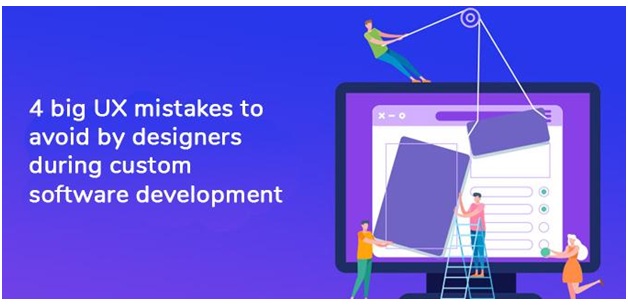In any custom software development process, the UX design is a critical factor. Why? It’s because the UX or the User Experience design is responsible for delivering a specific experience to users that boot their satisfaction level from using a software product or a website.
A good UX should be engaging, appealing, and takes a user on a smooth journey, right from the landing page to the completion of the conversion needed. UX design is more than creating several attractive buttons and a beautiful layout. UX designers should take into account a user’s possible journey, and in general, make a user-centred work to lead them through the website, and let them interact with the targeted touchpoints.
So, what should be your definition of a wonderful experience? Get close to your end-users, talk to them and watch the way they use the product, get inside their minds, and ask questions regarding their decisions. Pay attention because customers and users will teach you.
In custom software development services, creating a UX that’s engaging means that developers should have careful planning when creating the design. As much as possible, errors should be avoided. But, what are these errors? Let’s find out
Table of Contents
Mistakes to Avoid during Custom Software Development
Mistake No. One: Forgetting the mental model of Users
A mental model is in the user’s mind, which corresponds to the expectations of users regarding a product. Basically, it’s what users expect based on their needs, previous experience, similar products, and so on. So, it could be an issue if a user tests a product and it won’t match with his/her mental model.
Many designers focus on their own concept, such as the way they see a product, and failing to take into account the possible user needs. Thus, there’s a mismatch between a couple of models. Although this may not always be bad, there are instances when a mismatch is very drastic that it leaves a user entirely disappointed in the software.
UX designers should take both models into account when working on a design. The design should be clear and attractive, but at the same time, it shouldn’t only appeal to the taste of the user but should also cater to the true needs of the end-users.
Mistake No. Two: Innovation that Jeopardizes Usability
Users, when visiting an eCommerce website expect to see the shopping cart located in the upper right corner, which is a universal UX rule for this type of site. However, if a custom application development designer decides on changing and innovating the ordinary course of life, it could confuse users.
A user who lands on the home page and doesn’t get to see the cart in the usual place, it could turn them off and could even cause them to refrain from further shopping. The main thing to keep in mind is to not implement innovation to the backbone of elements, which help a user navigate fast.
Mistake No. Three: Immaterial Content that Messes Navigation
CTA or call-to-action elements, like buttons are critical since they motivate users to take the action intended and lead them to conversion. Nonetheless, CTAs could be ineffective sometimes since they entirely mess up navigation and prevent users from the actual app or website navigation.
By blocking the screen with unimportant visual elements, you interfere with the natural journey of the customer, remove control from users and rather, pressure them to do a specific action. All this will lead to truly inferior user experience and will frustrate and annoy users. Therefore, when you build a software product, adding the CTA visual elements only in relevant pages is critical, and only after a specific time period, when users are amply acquainted with the product.
Mistake No. Four: Using Carousels
Carousels, for some reason, are extremely popular, but as a matter of fact they often quite don’t bring value to users. Check out the cons of having carousels on a website:
- Taking control away from a user by changing images automatically.
- Distracting users from page content.
- No real value at all; they’re just additional information.
- Encourage users to scroll down and get the actual information available.
A carousel, in short, is only a huge image with a sort of a copy on it, thus it’s no wonder that users opt to skip it. If you must add a carousel to your website, make certain that users could control it and put a valuable offer on every image.
Make UX Design Work for You
Your brand only gets to benefit from apps when a user is using them successfully and the success comes from an intuitive design, which anticipates the user’s needs. To foresee these needs involves time spent in interacting with those using the product to understand the frustrations, goals, challenges, and motivations. The more an app developer of a custom software development company like Tatvasoft UK understands about the user, the more efficient and the better he/she could design an app.
Here are five ways that a well-designed UX could benefit your brand.
- Acquisition of Customers
Successful UX provides a competitive edge. It likely overtakes rice as the major brand differentiators that draw new customers. A great brand UX is more than effective product design, it’s actually good business.
- Lessen Support Expenses
A well-designed UX simply works. If an app has an inferior design, there would be more need for documentation, training, and support later on, which translates to higher expenses. An easy to use and intuitive app puts less stress on the employees and the bottom line.
- More Productivity
Better user experience could lead to improvements in productivity. When you take into account the improved productivity than the number of users and the number of hours that a user is active every single day, the financial impact is very apparent and substantial.
- Retention of Customers
By creating an enterprise UX that’s intuitive and beautiful, more and more people would want to use naturally, And, more importantly, they will keep on using it. In the digital world today, customer retention is increasingly critical since competition escalates with every advancement in technology.
- Reduces the time of Development
Around fifty percent of engineering, time is spent redoing work to fix errors that could have been in the first place avoided, such as wrong assumptions about the way users would behave, confuse navigation that will cause a user to get lost or stuck, encountering a new feature that no one wants to use. Making certain that the design is done right and well the first time around prevents problems in the long run.
Conclusion
As technology continues to evolve, it has become all the more important for an organization to embrace UX design, not only as a one-time event but as a continuous, fluid part of the business strategy for the long term. When customizing software and web solutions, developers should always strive and aim not just to create an aesthetic User Experience design, but one that could lead users to smooth and seamless navigation as well.






